
Oh no! A Seville! When Cadillac sold luxury cars, and where never was heard, any combover word. Yes, the bustle back Seville. Banks of computers are coming online, electricity is churning and burning, as certain RG folks immediately start typing madly, seeing this blast from the past. Great walls o’ text, saying in multiple paragraphs and for the 4,782nd time, I do not like that car, good sir. Oh crap, the RG server is beginning to smoke. BeepabeepabeepabeepaAWOOGAAWOOGAAWOOGA!
Yes, indeedy! *cackles madly*
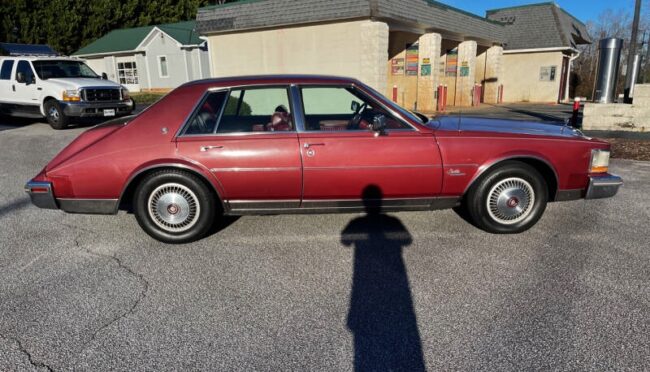
I like em. You know I do. Probably because I had both the Hot Wheels and Pocket Cars ’80 Sevilles as an impressionable gearhead kid. But no one would argue this design was a love it or hate it proposition. The original Seville (well, excluding the hardtop Eldorado Sevilles, made from 1956 to 1960) was a thoroughly modern design.
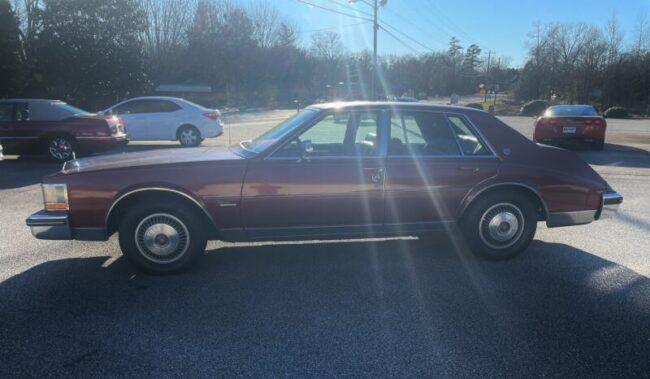
As a result, it found favor with younger buyers. So why GM decided to do this baroque design for the second generation version is hard to understand. Of course, Bill Mitchell wanted a striking design like this as his swan song, and before he retired, Mitchell pretty much got whatever he wanted. The new Seville looked like something Mr. Burns would buy, not a thirtysomething tennis couple. Oh well.
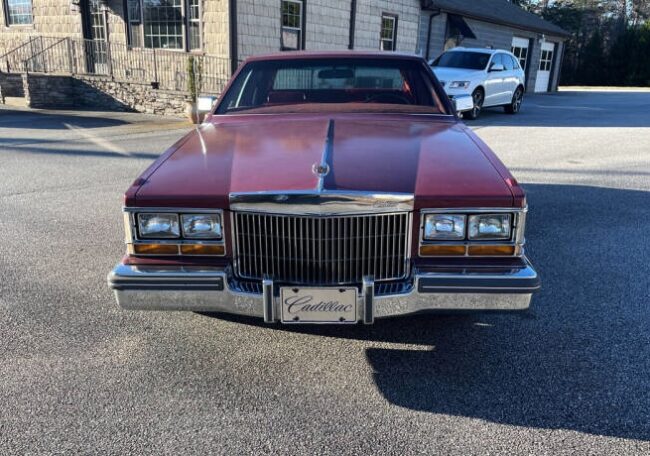
This one appears to be an early build, as it doesn’t have the French curve chrome accent molding later non-Elegante Sevilles all received. It appears to be in very nice shape, and I love those alloy wheels. So much cooler than the wire wheel covers seemingly 92% of these cars had. And red with red leather is always a plus in your author’s book. Though this is technically Victoria Plum Firemist, an extra-cost color.
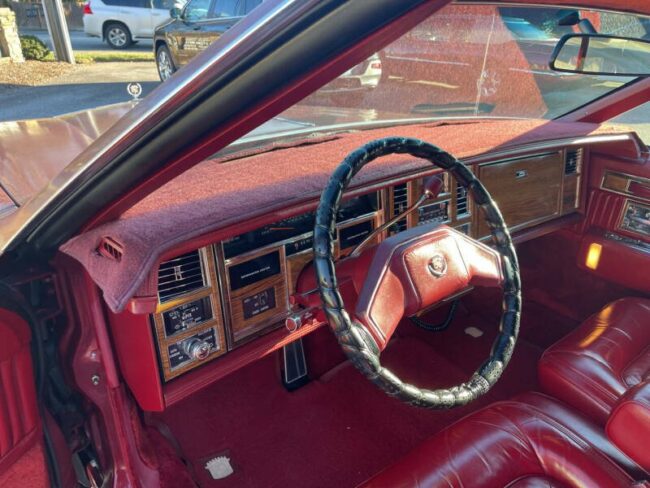

It’s currently on offer at a car dealer in South Carolina, for $3850. UPDATE: My friend Ryan Lockhart, a fellow Broughamophile, just bought it! A steal, in my opinion. And since this is an ’80, it has the good engine, the 368 CID V8. If you want one of these, an ’80 or ’81 is the one to get, as the ’82-up Cadillacs were, ah, rather leisurely with their HT4100 engines.
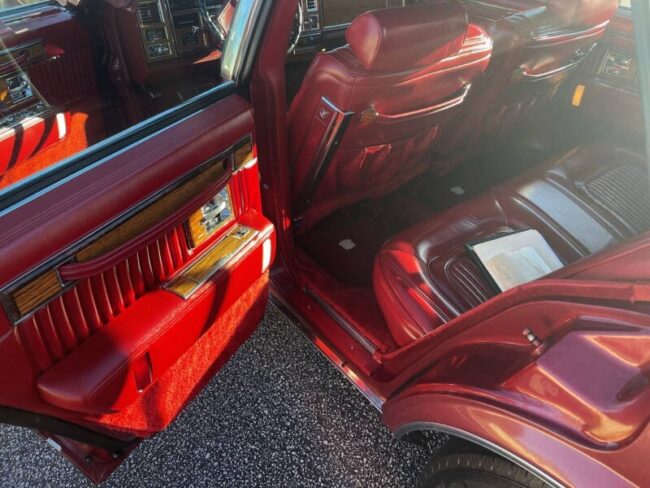
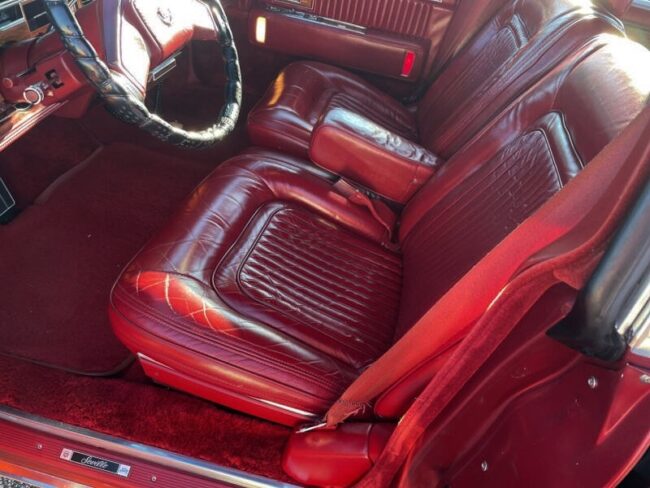
If I got it I’d add whitewalls and simply enjoy it. I’m sure one of these would draw a lot of interest at cruise nights and car shows. You can only look at so many red Corvettes, Mustangs and Camaros before your eyes glaze over!
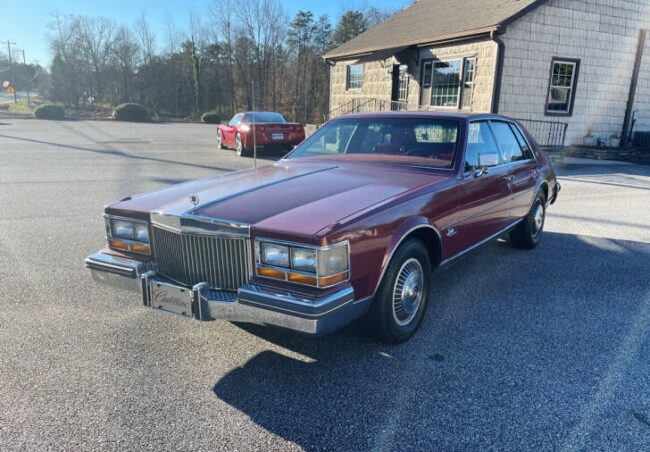








39 Comments
Agreed on the white walls. They just look odd without.
These really are an interesting car. From a technology and engineering perspective, these were a huge step forward over the original. Even the move to front wheel drive was seen as a cutting edge move at the time. While the characterization of the first gen Seville as a gussied up Nova was unfair and just plain wrong, the argument could be made that this was the car that the original Seville was supposed to be. And as at that point, luxury still mostly meant luxury, not sports/luxury, this really was a perfect car for Cadillac to take on the 80’s with.
Except…
That styling. I can’t say I hate it, and I remember at the time people being impressed with it. It looked expensive. It looked luxurious. It made a strong statement. However, it looked that way to either the people who weren’t buying them, or to the customers they didn’t want for the Seville. That being, the Florida white shoe set. While the first gen Seville worked, for the average buyer, as a worthy Mercedes competitor, keeping in mind that most luxury car buyers never use the performance built into their cars, I just can’t imagine anyone interested in a Mercedes in 1980 looking seriously at the new Seville.
Which is all a shame, as the car was a dramatic improvement in every way over the first generation, and could have been a comparable, if different, competitor to the Europeans for Cadillac. So Cadillac ended up trading short term sales, for destruction of their long term market.
Btw, has anyone every seen a design for this car that did not include the bustle-back? Essentially a 4 door Eldorado, I would guess, which wouldn’t necessarily be a bad thing.
I think your assessment is pretty spot on. This was an advanced car for 1980. The styling was a big swing and a miss – but at least GM tried to do something bold. I don’t think anything Cadillac could have done at the time would have been taken too seriously by German car buyers. The third generation Seville was closer to the mark – I always kinda liked the STS version of that car – but it was an even bigger flop than the bustle-back.
I don’t think an Eldorado-style rear would have worked on this car, though. Besides trying to make a (failed) styling statement, the bustle back was a practical way to resolve the packaging problem of trying to turn the E-body into a sedan. The wheelbase and overall length are unchanged from the Eldorado. A more traditional trunk would have been too stubby-looking and small inside without either compromising the back seat area or having an awkwardly long overhang.
The bustle-back balances out the long front end and adds a bit of cargo room at the same time. It’s a polarizing design, and it’s certainly not my favorite, but at least it serves a purpose and is elegant in its own way. I can’t say the same about the copycat ’81 Imperial and especially the ’82 Continental.
Now that the CT6 is much stumpier with much slopier over hangs, maybe the bustleback style can work. Chrysler did it much better on there last Imperial, and it looked a lot better simply because the front sloped too.
Its the Rolls Royce/Daimler/Austin Princess of Cadillacs!!! Enjoy the 1930s-50s look of a fine British car, but with all the reliability and conveniences of modern Cadillac.
No butler, top hat or monocle required…..
The 368 is a grossly over-rated engine all these years later. Even before V8-6-4-0,the 368 was a dud compared to both the Oldsmobile 350 used in Eldorados and the 425 used in everything else. I have a CandD road test of a 425 Coupe DeVille. It wasn’t quick, but it returned 16.5 city and 17 miles per gallon on the highway. No 368 ever achieved that in a period review, while the loss of 30 horsepower relative to the Olds and 40 horsepower relative to the 425 did show up in testing.
Had the second-generation Seville turn out looking like a four-door Eldorado with an injected Oldsmobile 350, this car would not be considered part of Cadillac’s 1980s apocalypse.
I’m sure the 368 was a pure CAFE decision that tested well on the unrealistic EPA test cycles, but in the real world got worse fuel economy than the less stressed 425 while delivering a whole lot less performance.
I think people look on the 368 fondly, just because the 4.1 replaced it. I can’t imagine more of a performance failure then the 4.1. It was just an insanely small engine for those huge beasts. Too bad Cadillac didn’t have a GM with any balls back then, as he should have torpedoed the 4.1 from any Cadillac duty before the downsized 85 SdV.
Amazingly, Cadillac managed to develop it into a damn fine engine in 4.9 litre form, before putting it out to pasture with the N* release.
It hung around for a few years after the Northstars came out, though 1995 in the “grandma spec” DeVilles, it was still the base engine in the non “Touring” Eldorado and Seville for a year or so in 1993-94.
You are right! I never thought of it much, because every Cadillac I would have been interested in at the time would have had a Northstar.
California 1980 Sevilles and Eldorado’s still had the fuel injected Oldsmobile 350.
The injected Oldsmobile motor should have just become the standard Cadillac V8 for the 1980’s, it already had the bugs worked out, Oldsmobile wasn’t using the gas 350 in anything after 1980 anyway. Cadillac should have just kept refining that engine. Perhaps keeping the 4.1 in the easybake oven for a few more years until the thermometer popped…..
I imagine the famous GM beancounters thought all that fancy multi-port fuel injection stuff was too expensive, while the Cadillac brand managers thought it was important to have a true Cadillac engine in their flagship products, and GM top brass were concerned about meeting CAFE regs, so they compromised with the thirsty (but good in EPA test), cheap (all cast iron, OHV, throttle body FI), and gutless Cadillac 368.
Meanwhile, it is hard to imagine what the engineers and managers assigned to the HT4100 were thinking…How do we create a relatively expensive engine (aluminum block) that will be unreliable, powerless, and still be technologically backwards (OHV, 16 valve, cast-iron heads), and follow it up with a 5-10 year plan to refine the engine into what it should have been at the beginning after we have pissed all our life-long customers off just before they die.
My theory was that they never intended the 4.1 for RWD. It must have been an arguement within GM whether Cadillac gets to keep a proprietary engine. The late seventies undisclosed engine sharing leading to lawsuits in lower brands probably won the day. Then the V8-6-4 not saving the last big block by reliably gaming CAFE put them in a fix. In the front drives, the properly balanced, lite 4.1 was an obvious upgrade over the 3.8 V6 where the balance shafts were a few years off. Pushing it out earlier in the RWDs did not work well even though that was when a OD auto and much shorter final drive was added to compensate for less torque.
We see how the 4.1 went from 125 horsepower in 1982 and only 82 to 200hp in 89 with no loss in economy. A 60% increase. Having solved a now frozen CAFE. Imagine the 140hp 368 going to an equivalent 225hp in the same period. The 89 Town Car had 155hp in comparison
Your theory makes a lot of sense. The V8-6-4 could not have been cheap to produce, and didn’t make a lot 0f sense as a 2 year option. The question then is was the 4100 rushed into production? It’s hard to imagine a company hurrying to replace one reliability disaster (V8-6-4) with one that was arguably worse (4100). Has any luxury car maker screwed more things up then Cadillac from 81-85? They basically got everything wrong.
Remember the 368 was very closely related to the previous 425 and indeed the 500 and 472 Cadillac V8s before it. It was a sturdy engine. The mechanism that turned off and on cylinders was troublesome, often leading to stalling. Owners could easily disable it but Cadillac couldn’t sell it disabled as that left the car a gas guzzler.
While I don’t remember the exact details of early 80s fuel economy rules, would Cadillac just not have been better off biting the bullet on a gas guzzler tax hit, and keeping the 368 in production as is? It’s not like Caddy buyers would have been unable to afford the tax, or the extra gas.
To your point, the big block Cadillac was indeed a truly great engine. Matched to the TH400, it was a smooth and refined as any drivetrain combo I’ve ever experienced. Cadillac could have kept developing it through the 80s, following Chevys example with perhaps aluminum cylinder heads and TPI? It would have been a 200 hp engine by the mid 80s and would have added a ton of refinement to the Fleetwood. And likely some sales too.
If I get to play Cadillac GM of the 80s some more, the D body had a fair bit of life left in it, and with the some proper refinement, and improvement in materials quality, it could have remained Cadillacs flagship for another decade at least.
I don’t know the answer if they could have politically just keeping the big engines and pay the fine. When the gas guzzler tax was expanded to retail for 86, the only domestic that released a car that owed it was the Fifth Avenue Chrysler, by then on borrowed time. Even after all the work on weights think of the extra expensive efforts like the variable displacement or the first to fourth shift on stick shift Corvettes to avoid being labeled.
GM Corporate decided that they were not going to pay any gas guzzler penalties/fines and so their fleet average was going to hit the CAFE targets, which meant that Cadillacs had to do well on the EPA tests. In contrast, BMW, MB, Bentley, etc. decided to offer high performance variants and pass the consequent gas guzzler tax on to the buyers, who gladly paid to have a powerful fast car, while Cadillac owners had to make due with 105 HP diesels, and 125 HP “High Technology” 4.1 V-8s. If GM management had had some balls, they would have told the EPA to FO.
It’s also worth that remembering that the front-drive C-bodies were originally supposed to debut in ’83 and got delayed. The HT4100 was rushed into production in response to the V8-6-4 disaster, but should have been a one year stopgap. The 368 and V8-6-4 weren’t intended to last more than a year or two, either.
No RWD B/C/D body, even the Chevy, was expected to live past ’82/’83. Gas was supposed to be $3.00 a gallon in 1985.
In hindsight, they should have just gone with the Olds 307 that was in every rear drive Oldsmobuick of the era. It’s not like Cadillac wasn’t already using Olds engines (and Buick V6s). Perhaps supply was an issue – which would explain why the Brougham finally got that motor immediately after the Delta 88 and LeSabre got downsized.
At least the HT4100 (and the LF9 diesel) was capable of running reasonably well until the head gasket blew, whereas the V8-6-4 didn’t run right from day one.
stingray65,
“GM Corporate decided that they were not going to pay any gas guzzler penalties/fines and so their fleet average was going to hit the CAFE targets, which meant that Cadillacs had to do well on the EPA tests.”
I guess GM was at a disadvantage because they sold so many Cadillacs during the era. Ford could offset Lincoln fuel economy with hundreds of thousands of Foxes and Escorts. Chrysler sold dozens of K-cars and Omnirizons for every New Yorker Fifth Avenue. GM was selling two or three hundred thousand Cadillacs when they were making the decisions that determined that Cadillac ownership would become a point of shame instead of pride. Even with their overall volume of the time, GM couldn’t afford to sell hundreds of thousands of cars that averaged 11 miles per gallon.
…it is hard to imagine what the engineers and managers assigned to the HT4100 were thinking…
Nah, easy to imagine. It was simply part of GM’s practice of the time of using their paying customers as beta testers.
Works for Tesla…..
I’m not sure I’ve ever defended Tesla before, but here goes. Tesla addresses most of their lagging development issues with over-the-air software updates. GM’s plan for dealing with customers who received cars with unresolved issues relied on more suckers being born every minute.
I’m actually referring more to the “self driving….most of the times it works, sometimes it kills you” beta testing Tesla owners enroll in everyday…..
A 4100 may blow up…..but it didn’t put you into a jersey curb at 80….
In terms of the domestic, the Seville, now on a luxury platform, facing the last of the Versailles and fancy Lebarons looked pretty secure. The upcoming prospect of bustle back Imperial Miradas and bustle back Continental Fairmonts must have reassured as to style choices.
An interesting question to me is what Rolls Royce thought of the Seville. That same year they rebodied the Shadow with a more bland, modern, aero look. For shoestring RR, a rebody is a near death level expense. The result was worldwide sales going from 3344 in 1979 to 2387 in 1982. I wonder if there were second thoughts as to not offering more classic inspired styling. At the next rebody in 1998, there was a more traditional alternative to the Seraph planned out but not chosen.
Was that drop caused by styling or just world wide trends at that time? Aston Martin almost went out of business in 80-81, and Jag hit their low in sales volumes iirc. Even Cadillac hit slaughtered in 1980.
All that being said, I’m not arguing that the Rolls redesign was a successful one. It’s often felt to me like another model of the 1977 GM downsized big cars. But perhaps not done as well. While it worked better as a Bentley, it immediately lost all the Rolls exclusivity from day one. It looked like any bland 80s car, with a Rolls grille tacked onto the front. The Silver shadow looked better in the beginning, and aged much better.
I believe the RR Spirit was basically a significant facelift of the much prettier Shadow, which meant many of the hard points were fixed and there was only a limited amount they could do on their shoe-string budget.
When the SZ Spirit came out in 1980, Rolls Royce announced the development and tooling cost 28 million pounds. The total sales in 1979 were 96 million pounds and a few months earlier to whole company was sold for 29.5 million pounds worth of stock in Vickers PLC. Prototypes with a close to final shape were in testing by 1975. This info is from one of recently deceased Graham Robson’s volume 4 of Rolls/Bentley history. RIP
The fact that the Silver Seraph lasted through ’97 with ’60s mechanicals and without so much as a tweak to the tail lights tells me it was a fairly successful redesign. And anybody who was dead set on a more classically-styled Rolls-Royce could get a Corniche through ’95.
Moreover, Seville sales went from 53,847 in 1979 to 19,998 in 1982. The Roller’s sales decline, despite costing four times as much, looks pretty good in comparison.
Not to be pedantic, but the basic 1966 car lasted till 2012 in the Bentley Brooklands, The best sales year was 1978.
Not to be MORE pedantic, but the Brooklands is an Arnage coupe, not a Spur/Mulsanne coupe.
The last descendant of the Silver Spur was the 2003 Continental R.
That presumes the Seraph/ /Arnage was not another rebody, it was. The big expense, that drove them into German hands was having to make the bodies in-house, as Honda owned Rover had shut down Pressed Steel.
I presume it because it’s a safe presumption: I have two well-researched contemporary books about the car, including one by the chief stylist Graham Hull, and they make it plain how little the Seraph/Arnage shared with the Spur/Mulsanne. The Seraph had all new “hard points” and was always intended to wrap around BMW engines, even before the German purchase drama, because BMW and Vickers had been partners.
Having driven the Shadow/T2, the Spur/Turbo, and the Arnage, I can say that the similarities are far greater between the first two than between #2 and #3. The Seraph/Arnage looks pretty clean sheet inside and out. Far more so than, say, the difference between the Panther generations.
Sevilles sales re-bounded somewhat to 39,000 plus for the 1984-1985 MY.
They were also at 39,000 in 1980, pulling the worst sales figure our of the entire generations run during a recession isn’t really good use of data….just saying.
1980 39,344
1981 28,631
1982 19,998
1983 30,430
1984 39,997
1985 39,755
And every one of those years is still down from 1979. I used 1982 solely because that was the year John cherry-picked for his bizarre argument that the Silver Spirit sold worse than the Silver Shadow because Rolls didn’t make it a bustle-back.
That said, I think the numbers are actually pretty good for a supposedly-infamous styling flop, with legendarily unreliable powertrains, during a period when car sales were bad in general.
The real flop was the cleanly-styled, Euro-sized third generation Seville crashed back down to around 20,000 sales and pretty much stayed there. Go figure – turns out unique styling was a Cadillac selling feature and Mercedes buyers weren’t going to be interested regardless.
In the sense that the bustle-back appealed to Cadillac buyers of the early 80s, but not Mercedes buyers, I am sure that is accurate. Unfortunately for Cadillac, the average Cadillac buyer of that time was over 60 and the average MB buyer was probably late 40s, which meant that appealing to Cadillac buyers meant going to grave with them.
The 2nd gen was also received a decent bump in price compared to he 1st gen as well.
The Seville sales were up 52% in 1983 from Carmine’s numbers. Rolls Royce sales fell again in 1983 to 2270. The peak 1978 number was not matched till 1990 when the Bentley Continental coupe came out. The numbers understate how bad sales were as the 80s saw a pickup in lower priced Bentleys. More of the strippo Bentley Eights than turbo Mulsannes. The designer of the Silver Spirit, John Hollings who replaced Shadow designer Harry Grylls, was pensioned off in 1982.
For the record, I have no idea if razoredge styling would have improved Spirit sales. RR would have been more free to use a handmade RR grille in the front than Cadillac, In 1980, knockoff and not handmade RR grilles were more associated with Lincoln. Sadly as part of the long decline, the 98 Seraph’s grills were no longer made by hand.